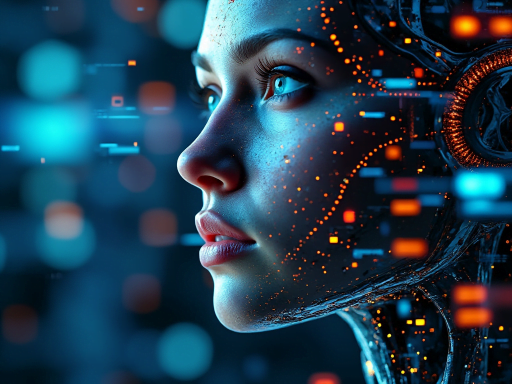
Introduction
Artificial Intelligence (AI) and Machine Learning (ML) are redefining the boundaries of what technology can achieve. In 2024, AI has become a dominant force across industries, affecting healthcare, finance, creative fields, and automation. These advances are being fueled by innovations such as generative AI, AI agents, and smaller, more efficient models that can be deployed on consumer devices, enabling real-time, data-driven decision-making on a broader scale.

What Is Artificial Intelligence (AI)?
Artificial Intelligence (AI) refers to the development of computer systems capable of performing tasks that normally require human intelligence. This includes decision-making, natural language understanding, and visual perception. AI is categorized into Narrow AI (designed for specific tasks like voice recognition) and General AI, which has the theoretical ability to perform any cognitive task a human can.
In 2024, AI is seeing a push toward more context-aware systems, with AI models now capable of interpreting data across multiple modalities such as text, audio, images, and even video, creating a truly holistic understanding of the environment.
What Is Machine Learning (ML)?
Machine Learning (ML) is a subset of AI that enables systems to learn from data and improve over time without human intervention. Innovations like Low-Rank Adaptation (LoRA) and quantization techniques are making ML models smaller and more efficient while maintaining their performance. These improvements are enabling ML applications to run on consumer devices like smartphones and IoT systems, reducing the need for cloud-based processing and improving privacy by keeping data local.
Key Differences Between AI and ML
AI refers to machines simulating human intelligence, while ML is a technique allowing machines to learn from data. All ML systems are AI, but not all AI systems rely on ML. This distinction is important because it helps clarify how AI technologies apply to different problems.

Major Advancements in AI and ML in 2024
1. Generative AI’s Growing Impact:
In 2024, generative AI models like Gemini Ultra and GPT-4 are expanding into new domains, including video generation, advanced image creation, and multimodal synthesis. These models have improved significantly in efficiency, accuracy, and generating high-quality, coherent content across media. With applications ranging from content creation to business intelligence, generative AI is becoming an indispensable tool across industries.
2. AI Agents Revolutionizing Task Automation:
AI agents, capable of performing complex tasks autonomously, are one of the most significant advancements of 2024. Moving beyond simple chatbots, these agents can now integrate with multiple services, plan trips, manage finances, and complete tasks without human oversight. The rise of these AI agents marks a shift from passive to active AI, where systems take initiative and make informed decisions based on contextual data.
3. Smaller, More Efficient AI Models:
With cloud costs rising and hardware constraints such as GPU shortages, there is a significant push towards developing smaller, more efficient models that can be deployed locally on devices. Techniques like LoRA and quantization reduce the computational resources required for training and deploying models, making AI more accessible to smaller companies and individual developers.
4. Edge Computing and AI at the Edge:
Businesses are increasingly deploying AI on edge devices like smartphones, IoT sensors, and drones. By processing data locally, these systems can operate with lower latency and greater privacy. This is especially important in fields like healthcare and autonomous vehicles, where real-time decision-making is critical.
5. Deepfake Proliferation and Regulation:
In 2024, deepfakes—AI-generated content that can mimic real people in videos and audio—are expected to become more widespread and harder to detect. Legislative bodies in regions like the EU are developing regulations to combat misinformation and ensure ethical AI use.

Real-World Applications of AI and ML
- Healthcare: AI continues to revolutionize healthcare with models like DeepMind’s AlphaFold, which predicts protein structures and accelerates drug discovery. AI is also enabling more personalized treatments by analyzing patient data to identify the best therapeutic options.
- Finance: AI is streamlining operations in the financial sector by providing enhanced fraud detection, automated trading, and AI-powered customer service. Machine learning algorithms help predict market trends, assess credit risks, and optimize portfolios.
- Autonomous Systems: AI is advancing robotics and autonomous vehicles, enabling more sophisticated decision-making in real-world environments. Self-driving cars, drones, and robots now use AI models to enhance autonomous operations in complex environments.
- Creative Industries: In the arts and entertainment sectors, AI is transforming creative processes. Generative AI is being used to produce high-quality videos, generate music, and even assist in scriptwriting, offering creators new ways to bring their ideas to life.
Benefits of AI and ML for Businesses
- Cost Efficiency: AI reduces operational costs by automating repetitive tasks, allowing businesses to allocate resources more efficiently.
- Improved Decision Making: ML algorithms analyze large datasets to provide actionable insights and uncover trends, enabling data-driven business decisions.
- Personalized Customer Experiences: AI enables businesses to offer highly personalized products and services by analyzing customer behavior and preferences.
Challenges in Implementing AI and ML
- Data Privacy and Security: With AI systems processing vast amounts of sensitive data, privacy and security are key concerns. Organizations must implement stringent data governance frameworks to ensure compliance with regulations like GDPR.
- Skill Gaps: The shortage of skilled professionals capable of developing and maintaining AI systems limits these technologies’ adoption.
- Bias and Fairness: Bias in the data used to train AI systems can lead to significant ethical concerns. Ensuring fairness and transparency in AI decision-making is a major challenge.

The Future of AI and ML
Looking ahead to the rest of 2024 and beyond, AI and ML will continue to revolutionize industries. The development of autonomous AI agents, capable of independently completing tasks, will disrupt logistics and customer service. Generative AI will expand further into video production, content creation, and even scientific research, offering unprecedented opportunities for innovation.
As AI systems become more advanced, the emphasis on responsible AI practices will grow. Governments and organizations will continue to develop frameworks that ensure transparency, fairness, and accountability in AI applications.
Conclusion
AI and ML are transforming the 2024 technological landscape, driving innovation across sectors like healthcare and finance. The advancements in generative AI, task automation, and edge computing are making AI more powerful and accessible than ever before. To ensure responsible use of these technologies, businesses must address challenges related to data privacy, bias, and governance. As AI evolves, collaboration between businesses and policymakers will be crucial to foster an ethical, transparent ecosystem.
Sources:
- McKinsey: The state of AI in early 2024(McKinsey & Company)
- IBM: AI trends in 2024(IBM – United States)
- Stanford HAI: What to expect in AI in 2024(Stanford HAI)
- AI Index Report 2024(AI Index)






